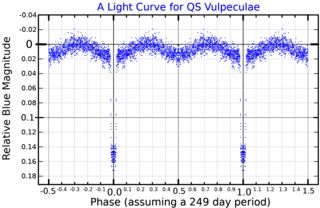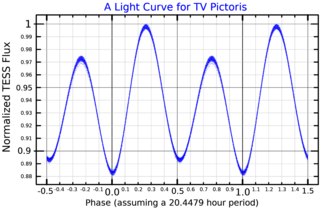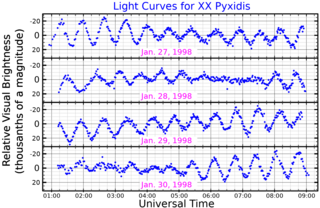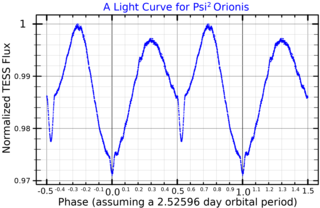A Gamma Cassiopeiae variable is a type of variable star, named for its prototype γ Cassiopeiae.

18 Aquilae is a triple star system in the constellation of Aquila. 18 Aquilae is the Flamsteed designation; it also bears the variable star designation Y Aquilae. It has an apparent visual magnitude of 5.07. The distance to this system can be estimated from the annual parallax shift of 6.43 mas, yielding a value of around 510 light-years away from Earth.
26 Aurigae is a binary star system in the northern constellation of Auriga. It is visible to the naked eye as a faint star with an apparent visual magnitude of 5.41.

2 Lacertae is a binary star in the constellation of Lacerta. With an apparent magnitude of about 4.5, it is faintly visible to the naked eye. Its parallax, measured by the Hipparcos spacecraft, is 5.88 milliarcseconds, corresponding to a distance of about 550 light years. It is projected against the Lacertae OB1 stellar association to the northeast of the main concentration of stars, but it is likely to be a foreground object.

Nu Centauri, Latinized from ν Centauri, is a binary star system in the southern constellation of Centaurus. The combined apparent visual magnitude of the pair is +3.41, making this one of the brightest members of the constellation. Based upon parallax measurements made during the Hipparcos mission, this star system is located at a distance of roughly 437 light-years from Earth. The margin of error for this distance is about 2%, which is enough to give an error in distance of ±10 light years.

Tau Cygni, Latinised from τ Cygni, is a binary star system in the constellation Cygnus, approximately 69 light years away from Earth. This visual binary system has a period of 49.6 years.

HR 2554, also known as V415 Carinae and A Carinae, is an eclipsing spectroscopic binary of the Algol type in the constellation of Carina whose apparent visual magnitude varies by 0.06 magnitude and is approximately 4.39 at maximum brightness. Its primary is a G-type bright giant star and its secondary is an A-type main-sequence star. It is approximately 553 light-years from Earth.

R Arae is an Algol-type eclipsing binary in the constellation Ara. Located approximately 298 parsecs (970 ly) distant, it normally shines at magnitude 6.17, but during eclipses can fall as low as magnitude 7.32. It has been suggested by multiple studies that mass transfer is occurring between the two stars of this system, and the period of eclipses seems to be increasing over time. The primary is a blue-white main sequence star of spectral type B5V that is 5 times as massive as the Sun, while the secondary is a yellow-white star of spectral type F1IV that is 1.5 times as massive as the Sun. Stellar material is being stripped off the secondary and accreting on the primary.

R Canis Majoris is an eclipsing interacting binary star system in the constellation Canis Major. It varies from magnitude 5.7 to 6.34. The system is unusual in the low ratio between the main two components and shortness of the orbital period.

22 Vulpeculae is a binary star system in the northern constellation Vulpecula. Based on its parallax, it is located some 1,490 light-years away, and it has an apparent magnitude of about 5.2, making it visible to the naked eye. The system is moving closer to the Earth with a heliocentric radial velocity of −23 km/s.
Lambda Cygni is a class B5V star in the constellation Cygnus. Its apparent magnitude is 4.54 and it is approximately 770 light years away based on parallax.

47 Cygni is a triple star system in the northern constellation of Cygnus, and is located around 4,000 light years from the Earth. It is visible to the naked eye with a combined apparent visual magnitude of 4.61. The system is moving closer to the Earth with a heliocentric radial velocity of −4.6 km/s.

b Persei is a spectroscopic triple star in the constellation Perseus. Its apparent magnitude is 4.60, and it is about 320 light years away.

λ Pavonis, Latinized as Lambda Pavonis, is a single, variable star in the southern constellation of Pavo. It is a blue-white hued star that is faintly visible to the naked eye with an apparent visual magnitude that fluctuates around 4.22. This object is located approximately 1,400 light years from the Sun, based upon parallax. It is a member of the Scorpius–Centaurus association.

QZ Puppis is a class B2.5V star in the constellation Puppis. Its apparent magnitude is 4.5 and it is approximately 650 light years away based on parallax.

TV Pictoris is a rotating ellipsoidal variable star in the constellation Pictor. It ranges between apparent magnitude 7.37 - 7.53 over a period of 0.85 days. It was first discovered to be variable in 1987. The system is inclined at an angle of 54 degrees to observers on Earth. It is composed of a primary star that has a radius 4.3 times that of the sun and 1.2 times its mass, and an effective (surface) temperature of 8300 K, and a secondary star with a radius 2.1 times that of the sun and 40% of its mass, and an effective temperature of 7000 K. Both stars are less massive than expected for a main sequence star of their temperatures. The secondary rotates much faster than the primary.

25 Serpentis is a star system in the constellation of Serpens Caput. With an apparent magnitude of 5.37, it is just barely visible to the naked eye. The system is estimated to be some 450 light-years based on its parallax.

XX Pyxidis is a star located in the constellation Pyxis. It has an apparent magnitude that varies slightly at about 11.5, and is about 2,300 light years away.

RR Centauri is a variable star of apparent magnitude maximum +7.29. It is located in the constellation of Centaurus, approximately 320 light years distant from the solar system.

Psi2 Orionis a binary star system in the equatorial constellation of Orion. It has an apparent visual magnitude of 4.6, indicating that it is visible to the naked eye. Based upon an annual parallax shift of 2.87 mass, it is roughly 1,100 light years distant from the Sun.

















